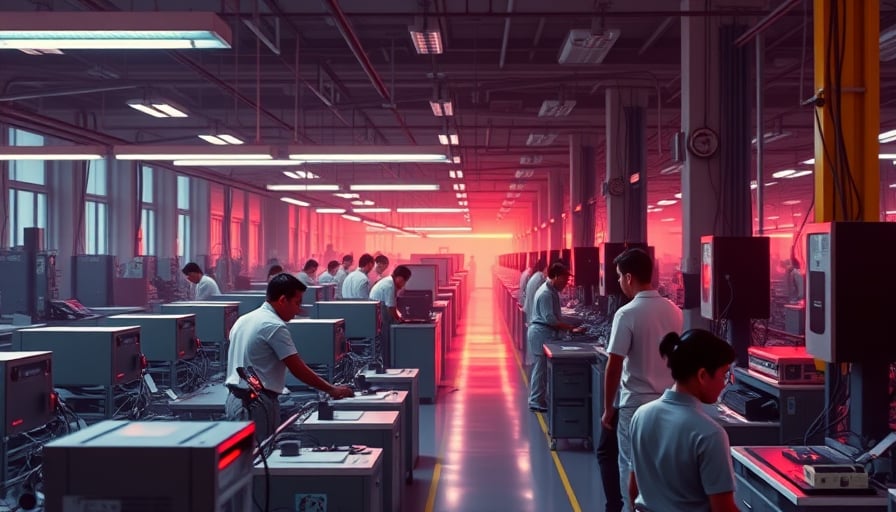Newonder Special Electric Co Ltd – A Case of Quiet Decline Amid Market Turbulence
The Shenzhen‑listed Newonder Special Electric Co Ltd (SZ301120) has slipped into the cross‑hairs of both institutional investors and regulatory watchers. Over the past two weeks, the company has faced a confluence of negative signals that erode confidence and cast doubt on its future trajectory.
1. Stock‑Trading Anomalies and Share‑holder Sell‑offs
On 10 October 2025, Newonder announced a “stock trading abnormality” after three consecutive days of closing price swings exceeding 30 % (on 30 Sep, 9 Oct, and 10 Oct). The announcement was unaccompanied by any material corporate event; the company affirmed that its operations remained normal and that no undisclosed information had affected its valuation.
However, the same day the company disclosed that its controlling shareholder, actual controller, and their concert parties—Tanyong, Zonglili, Li Shuqi, and Zong Baofeng—had sold a total of 11,132,400 shares over a 3‑month window. This represents 3 % of the outstanding shares (excluding repurchase‑specific securities). The sell‑off, executed through both auction and block trades, coincided with the abnormal price volatility and raised red flags among investors and regulators.
2. Quantitative Funds’ Selective Aggression
In the broader market context, quantitative funds were highly selective on 10 October. While Newonder was not a target, other peers such as Shenzhen Technology, Shanghai Power, and Landei Technology attracted the bulk of net inflows, with Shenzhen Technology alone pulling ¥501 million in the single day. Conversely, stocks like Geer Co., ShanShan Co., Yongding Co., and Zhongzhou Special Materials were net sellers. The sharp concentration of quantitative capital into a handful of names reflects a broader shift away from mid‑cap, high‑growth firms toward more established, cash‑generating players.
3. Sector‑Level Capital Outflow
The electric‑equipment sector, Newonder’s home turf, was a net outflow zone on 10 October. Total fund outflows amounted to ¥25.535 billion for the day, with the sector ranking second only to electronics. The decline in capital inflows was mirrored by a drop in the Shenzhen Composite Index, which fell 2.70 %, and by a 4.71 % decline in the electronics sub‑index. This environment makes it increasingly difficult for Newonder to attract fresh liquidity or justify its valuation.
4. The Company’s Position in the Emerging AI‑Power Supply Landscape
Newonder’s core product line—solid‑state transformers (SSTs)—is marketed as a critical component for next‑generation AI data centers. In a recent analyst brief on 19 September, the company claimed it was poised to capitalize on the shift from traditional UPS to HVDC and eventually to SSTs. Yet, despite this narrative, the company’s share price has not reflected any upside. The stock’s close on 9 October was ¥17.98, a modest 1 % rise from the 52‑week high of ¥18.33 (achieved on 18 August). Over the same period, the 52‑week low had fallen to ¥7.22, underscoring a prolonged downward trend.
5. Investor Sentiment and Risk Warning
The company’s own disclosure on 10 October emphasized that it would “warn investors of risks” and that all information would be released through official channels. However, the combination of abnormal price swings, a sizable shareholder divestiture, and sector‑wide capital flight erodes the credibility of such warnings. Investors must now grapple with the question: is the 3 % share sale a sign of insider pessimism, or merely an opportunistic profit‑taking move in a weak market?
6. Bottom‑Line Assessment
- Shareholder Confidence: The 3 % sell‑off by controlling interests is a stark signal that insiders are not banking on a near‑term rally.
- Capital Availability: Quantitative funds’ focus on other names and the sector’s net outflow create a liquidity squeeze.
- Valuation Pressure: The stock’s inability to move beyond a 1 % increase from its 52‑week high, while the broader index fell, indicates a lack of demand.
- Strategic Risk: The promise of SSTs in AI data centers is still speculative; the company has yet to demonstrate a clear path to profitability in this niche.
In light of these dynamics, Newonder Special Electric Co Ltd faces a challenging road ahead. The company’s ability to reverse the trend hinges on a combination of transparent governance, concrete product milestones, and an ability to attract new capital in an environment increasingly hostile to mid‑cap growth names. Until such measures materialize, the stock remains a high‑risk proposition for both retail and institutional investors.
